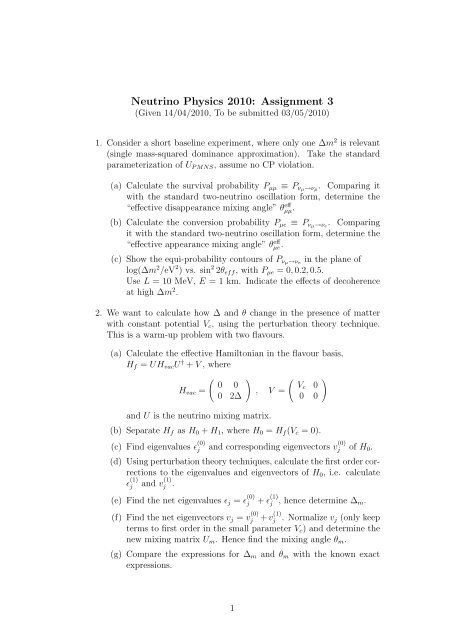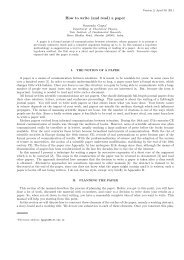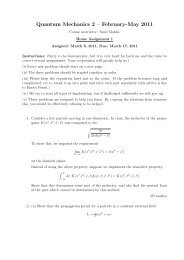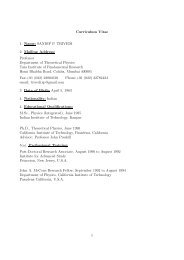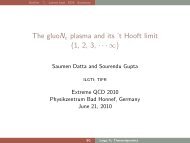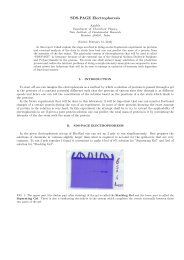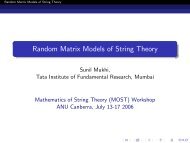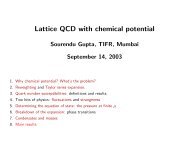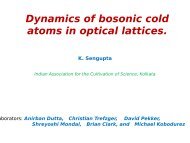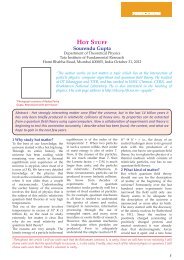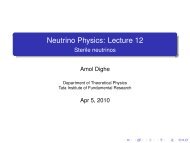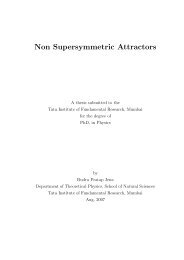Neutrino Physics 2010: Assignment 3
Neutrino Physics 2010: Assignment 3
Neutrino Physics 2010: Assignment 3
Create successful ePaper yourself
Turn your PDF publications into a flip-book with our unique Google optimized e-Paper software.
<strong>Neutrino</strong> <strong>Physics</strong> <strong>2010</strong>: <strong>Assignment</strong> 3<br />
(Given 14/04/<strong>2010</strong>, To be submitted 03/05/<strong>2010</strong>)<br />
1. Consider a short baseline experiment, where only one ∆m 2 is relevant<br />
(single mass-squared dominance approximation). Take the standard<br />
parameterization of U P MNS , assume no CP violation.<br />
(a) Calculate the survival probability P µµ ≡ P νµ→ν µ<br />
. Comparing it<br />
with the standard two-neutrino oscillation form, determine the<br />
“effective disappearance mixing angle” θµµ.<br />
eff<br />
(b) Calculate the conversion probability P µe ≡ P νµ→νe . Comparing<br />
it with the standard two-neutrino oscillation form, determine the<br />
“effective appearance mixing angle” θµe.<br />
eff<br />
(c) Show the equi-probability contours of P νµ→νe<br />
in the plane of<br />
log(∆m 2 /eV 2 ) vs. sin 2 2θ eff , with P µe = 0, 0.2, 0.5.<br />
Use L = 10 MeV, E = 1 km. Indicate the effects of decoherence<br />
at high ∆m 2 .<br />
2. We want to calculate how ∆ and θ change in the presence of matter<br />
with constant potential V c , using the perturbation theory technique.<br />
This is a warm-up problem with two flavours.<br />
(a) Calculate the effective Hamiltonian in the flavour basis,<br />
H f = UH vac U † + V , where<br />
H vac =<br />
(<br />
0 0<br />
0 2∆<br />
)<br />
, V =<br />
and U is the neutrino mixing matrix.<br />
(<br />
Vc 0<br />
0 0<br />
(b) Separate H f as H 0 + H 1 , where H 0 = H f (V c = 0).<br />
(c) Find eigenvalues ɛ (0)<br />
j and corresponding eigenvectors v (0)<br />
j of H 0 .<br />
(d) Using perturbation theory techniques, calculate the first order corrections<br />
to the eigenvalues and eigenvectors of H 0 , i.e. calculate<br />
ɛ (1)<br />
j and v (1)<br />
j .<br />
(e) Find the net eigenvalues ɛ j = ɛ (0)<br />
j + ɛ (1)<br />
j , hence determine ∆ m .<br />
(f) Find the net eigenvectors v j = v (0)<br />
j + v (1)<br />
j . Normalize v j (only keep<br />
terms to first order in the small parameter V c ) and determine the<br />
new mixing matrix U m . Hence find the mixing angle θ m .<br />
(g) Compare the expressions for ∆ m and θ m with the known exact<br />
expressions.<br />
)<br />
1
3. We want to calculate the conversion probability P νe→ν µ<br />
in three flavours<br />
in matter with constant potential V c .<br />
(a) Calculate the effective Hamiltonian in the flavour basis,<br />
H f = UH vac U † + V , where<br />
H vac = 2∆ 31<br />
⎛<br />
⎜<br />
⎝<br />
0 0 0<br />
0 α 0<br />
0 0 1<br />
⎞<br />
⎟<br />
⎠ ,<br />
V = 2∆ 31<br />
⎛<br />
⎜<br />
⎝<br />
 0 0<br />
0 0 0<br />
0 0 0<br />
Here  ≡ V c/(2∆ 31 ), α ≡ ∆ 21 /∆ 31 , and U is the neutrino mixing<br />
matrix.<br />
(b) Separate H f as H 0 + H 1 , where H 0 = H f (θ 13 = 0, α = 0).<br />
(c) Find eigenvalues ɛ (0)<br />
j and corresponding eigenvectors v (0)<br />
j of H 0 .<br />
(d) Using perturbation theory techniques, calculate the first order corrections<br />
to the eigenvalues and eigenvectors of H 0 , i.e. calculate<br />
ɛ (1)<br />
j and v (1)<br />
j .<br />
(e) Determine the net eigenvalues ɛ j = ɛ (0)<br />
j + ɛ (1)<br />
j and the net eigenvectors<br />
v j = v (0)<br />
j + v (1)<br />
j .<br />
(f) Normalize v j (only keep terms to first order in the small parameters<br />
θ 13 and α) and determine the new mixing matrix U m .<br />
(g) Using the net conversion probability<br />
calculate P eµ .<br />
∑<br />
P αβ =<br />
(U m ) ∗ βj(U m ) αj e −iɛ jL<br />
∣<br />
∣<br />
j<br />
4. Let there be a sterile neutrino, which is heavier than all the active<br />
neutrinos, with ∆m 2 ≈ 1 eV 2 . The net 4 × 4 neutrino mixing matrix<br />
is given by<br />
⎛<br />
⎞<br />
U e1 U e2 U e3 U e4<br />
U<br />
U = µ1 U µ2 U µ3 U µ4<br />
⎜<br />
⎟<br />
⎝ U τ1 U τ2 U τ3 U τ4 ⎠<br />
U s1 U s2 U s3 U s4<br />
Calculate<br />
(a) P µµ relevant for atmospheric neutrinos. Simplify to the extent<br />
possible by neglecting / averaging out appropriate terms.<br />
(b) P µe relevant for the LSND experiment. Simplify to the extent<br />
possible by neglecting / averaging out appropriate terms.<br />
(c) P ee relevant for the KamLAND experiment. Simplify to the extent<br />
possible by neglecting / averaging out appropriate terms.<br />
2<br />
,<br />
⎞<br />
⎟<br />
⎠<br />
2


